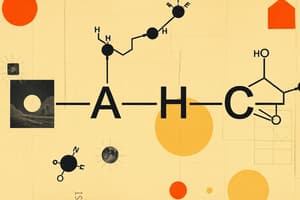Podcast
Questions and Answers
Which type of isomerism is specifically mentioned in the text?
Which type of isomerism is specifically mentioned in the text?
- Position isomerism
- Chain isomerism
- Geometric isomerism (correct)
- Functional group isomerism
In the context of organic molecules, what does E/Z notation refer to?
In the context of organic molecules, what does E/Z notation refer to?
- Number of functional groups
- Positional isomerism
- Chain length differences
- Geometric isomerism (correct)
What is the impact of bonding on the geometry of organic molecules?
What is the impact of bonding on the geometry of organic molecules?
- It affects the boiling point
- It influences the shape and structure (correct)
- It has no impact
- It determines the color of the molecule
How many hydrogen atoms are bonded to a high carbon atom as mentioned in the text?
How many hydrogen atoms are bonded to a high carbon atom as mentioned in the text?
What type of isomerism involves differences in the positioning of functional groups?
What type of isomerism involves differences in the positioning of functional groups?
How many atoms are bonded to a low carbon atom as per the provided text?
How many atoms are bonded to a low carbon atom as per the provided text?
'Low 48' in the text most likely refers to what aspect of the molecule?
'Low 48' in the text most likely refers to what aspect of the molecule?
'High C = 12' suggests what about this particular carbon atom's bonding?
'High C = 12' suggests what about this particular carbon atom's bonding?
'Bonds to: H, H, Cl' refers to what type of atom bonding?
'Bonds to: H, H, Cl' refers to what type of atom bonding?
'Low H=1 C = 12 High C = 12 C = 12' likely refers to what aspect of these carbon atoms?
'Low H=1 C = 12 High C = 12 C = 12' likely refers to what aspect of these carbon atoms?
Flashcards are hidden until you start studying
Study Notes
Organic Analysis
- Functional group tests:
- Alkene: Bromine water (orange → colourless)
- Aldehyde: Tollen's reagent (colourless → silver mirror), Fehling's solution (colourless → red ppt)
- Ketone: No reaction with Tollen's reagent or Fehling's solution
- Carboxylic acid: pH indicator (pH 3-6)
- Haloalkane: Silver nitrate/ammonia (white/cream/yellow ppt)
- Tests for specific functional groups:
- Alkene: Bromine water
- Aldehyde: Tollen's reagent, Fehling's solution
- Ketone: No reaction with Tollen's reagent or Fehling's solution
- Carboxylic acid: pH indicator
- Haloalkane: Silver nitrate/ammonia
Isomerism
- Isomers: molecules with the same molecular formula but different arrangements of atoms
- Types of isomerism:
- Structural isomerism (chain, position, functional group)
- Stereoisomerism (geometric, optical)
Structural Isomerism
- Chain isomerism: different arrangements of carbon chain
- Position isomerism: functional group on different atom on chain
- Functional group isomerism: different functional groups with the same general formula
- Examples:
- Alkanes/cycloalkanes (e.g. pentane, 2-methylbutane)
- Alcohols/ethers (e.g. butan-2-ol, methoxypropane)
- Carboxylic acids/esters (e.g. propanoic acid, methylethanoate)
- Aldehydes/ketones (e.g. butanal, butanone)
Stereoisomerism
- Geometric isomerism: E/Z notation for alkenes
- E/Z isomerism rules:
- Split the molecule down the middle, perpendicular to the double bond
- Compare atomic numbers of atoms connected to each carbon
- Prioritize higher atomic numbers
- Assign E or Z notation based on priority
Geometric Isomerism
- CIS/TRANS notation for simple alkenes
- E/Z notation for more complex alkenes
- Examples:
- cis-1,2-dichloroethane
- trans-1,2-dichloroethane
- Z-1,2-dichloroethane
- E-1,2-dichloroethane
Studying That Suits You
Use AI to generate personalized quizzes and flashcards to suit your learning preferences.



